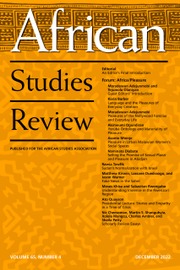Reading In the Shadow of the Global North: Journalism in Postcolonial Africa by J. Siguru Wahutu took me back to my journalism classes at the University of the Witwatersrand. To help us understand the colonial legacy in African journalism, the module Media & Society, fostered a critical engagement with the questions: do we have African journalism or African journalism ethics?
These questions remain pertinent today, and is the reason I find Wahutu’s book a timely contribution to African journalism studies. African journalism has gone through phases, from precolonial, colonial, to postcolonial. Thus, what we call African journalism today barely represents one, but all of these periods. I kept this in mind as I read In the Shadow to understand, as the book argues, how African journalists and news organizations have become complicit in silencing African voices, an emblem of Global North journalism.
The book analyzes the coverage of the Darfur conflict by journalists from different African countries. It concludes that: (i) News organizations in Africa are critical players in the silencing of African voices; (ii) African journalists are themselves part of the marginalization of African voices; (iii) Narratives employed by African journalists do not differ that significantly from those employed by journalists from the Global North; and (iv) African journalists use ethnic conflict frames with relative frequency when narrating a conflict.
The significance of the book is its attempt to understand why African journalists frame and present their continent in the same way as the Global North journalists and news organizations. The postulation that underpins this discussion is that journalism practiced in Africa is rooted in the Global North journalism culture and practice. This journalism is characterized by the marginalization of African voices. The argument is that a different kind of journalism—or simply put, African journalism—could provide something different, particularly in how African issues are framed and presented. This logic recognizes “sovereignty” and “African journalistic traditions,” as pillars for distinguishing African from Global North journalism.
In South Africa, the collapse of the apartheid regime in 1994 exposed the country’s press to serious scrutiny, which included searching for its sovereignty and journalistic traditions. The emphasis was on increasing the representation of black journalists in the newsrooms as a way of dealing with the marginalization of native’s voices. This campaign also meant changes in media ownership, content, audiences, and the role of the media in the country.
As Wahutu shows, this happened in most African countries at the dawn of independence. Sovereign media systems typified by African journalistic traditions became the prerequisite for the nation-building project in the new independent states. It was an attempt to deal with the marginalization of African voices in the media.
But more than 50 years later, as Wahutu demonstrates, African journalism is still rooted and shaped by the Global North journalism culture of marginalizing African voices. It is evident that it is not only about who is sitting in the newsrooms, but also what systems and philosophies guide journalism culture and practice on the continent. This is why I find it interesting that the author avoided the decolonial theory, of course with a good explanation. However, I believe the decolonial approach could have helped in going beyond answering the “what” and “how” questions to include a critical systematic review of the facilitators of this culture.
There was an attempt to take this route particularly in sections where the book examines the ways the Global North consolidates its dominance and how African institutions like journalism schools become complicit through imitation of the Global North journalism professional norms and ignoring local context in their curriculums.
Take, for instance, the continued dominance of the British Broadcasting Corporation (BBC) in Africa. Most of the first radio stations in former British colonies were established with the help of the BBC, and to date, African journalists and news organizations look up to the BBC as a model of good journalism. Even prominent figures like politicians prefer granting interviews to the BBC over their local media, a culture that consolidates the dominance of Global North journalism.
On the other hand, the BBC continues to invest in interventions that support and sustain its dominance and legacy in Africa. In the past, such interventions were largely dependent on Global North journalists, but now they rely on both groups. It is now common to see similar narratives on Africa constructed by an African journalist appearing in both Global North and Global South news outlets. Failure by African journalists to draw a line between writing for the Global North and Global South audiences illustrates the gravity of the problem. In the Shadow wants African journalists, news organizations, and journalism trainers to reflect on their role in consolidating the Global North journalism culture and the construction of knowledge about Africa.

